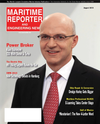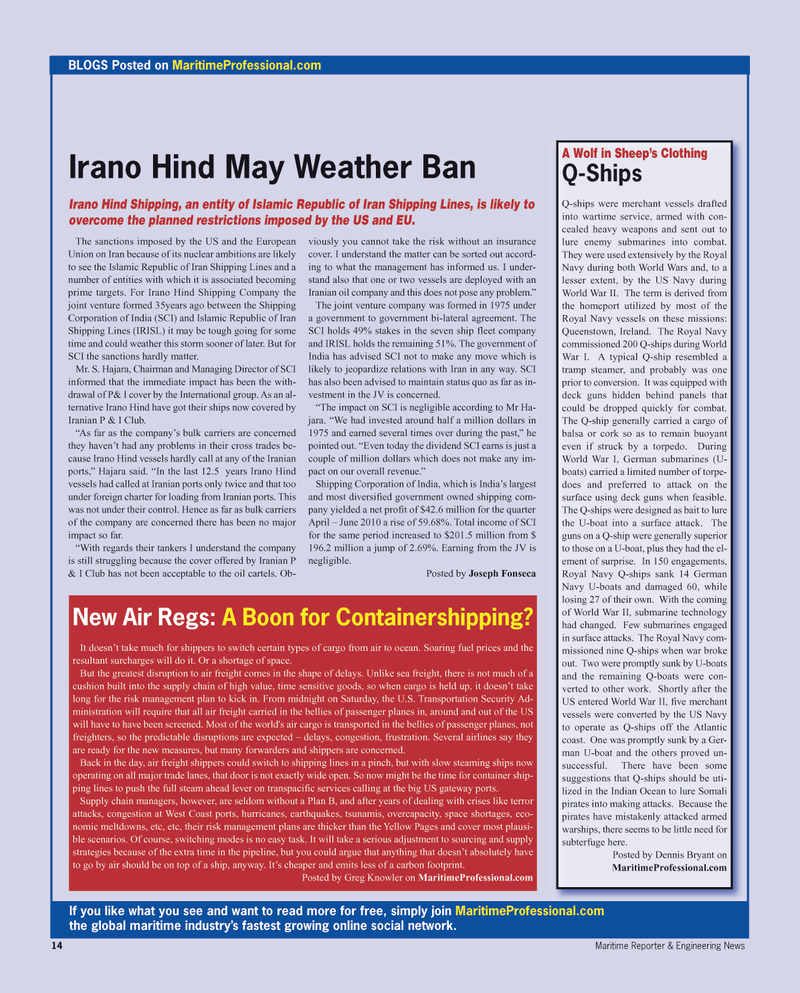
Page 14: of Maritime Reporter Magazine (August 2010)
The Electric Ship
Read this page in Pdf, Flash or Html5 edition of August 2010 Maritime Reporter Magazine
14 Maritime Reporter & Engineering News
The sanctions imposed by the US and the European
Union on Iran because of its nuclear ambitions are likely to see the Islamic Republic of Iran Shipping Lines and a number of entities with which it is associated becoming prime targets. For Irano Hind Shipping Company the joint venture formed 35years ago between the Shipping
Corporation of India (SCI) and Islamic Republic of Iran
Shipping Lines (IRISL) it may be tough going for some time and could weather this storm sooner of later. But for
SCI the sanctions hardly matter.
Mr. S. Hajara, Chairman and Managing Director of SCI informed that the immediate impact has been the with- drawal of P& I cover by the International group. As an al- ternative Irano Hind have got their ships now covered by
Iranian P & I Club. “As far as the company’s bulk carriers are concerned they haven’t had any problems in their cross trades be- cause Irano Hind vessels hardly call at any of the Iranian ports,” Hajara said. “In the last 12.5 years Irano Hind vessels had called at Iranian ports only twice and that too under foreign charter for loading from Iranian ports. This was not under their control. Hence as far as bulk carriers of the company are concerned there has been no major impact so far. “With regards their tankers I understand the company is still struggling because the cover offered by Iranian P & I Club has not been acceptable to the oil cartels. Ob- viously you cannot take the risk without an insurance cover. I understand the matter can be sorted out accord- ing to what the management has informed us. I under- stand also that one or two vessels are deployed with an
Iranian oil company and this does not pose any problem.”
The joint venture company was formed in 1975 under a government to government bi-lateral agreement. The
SCI holds 49% stakes in the seven ship fleet company and IRISL holds the remaining 51%. The government of
India has advised SCI not to make any move which is likely to jeopardize relations with Iran in any way. SCI has also been advised to maintain status quo as far as in- vestment in the JV is concerned. “The impact on SCI is negligible according to Mr Ha- jara. “We had invested around half a million dollars in 1975 and earned several times over during the past,” he pointed out. “Even today the dividend SCI earns is just a couple of million dollars which does not make any im- pact on our overall revenue.”
Shipping Corporation of India, which is India’s largest and most diversified government owned shipping com- pany yielded a net profit of $42.6 million for the quarter
April – June 2010 a rise of 59.68%. Total income of SCI for the same period increased to $201.5 million from $ 196.2 million a jump of 2.69%. Earning from the JV is negligible.
Posted by Joseph Fonseca
If you like what you see and want to read more for free, simply join MaritimeProfessional.com the global maritime industry’s fastest growing online social network.
BLOGS Posted on MaritimeProfessional.com
A Wolf in Sheep’s Clothing
Q-Ships
Q-ships were merchant vessels drafted into wartime service, armed with con- cealed heavy weapons and sent out to lure enemy submarines into combat.
They were used extensively by the Royal
Navy during both World Wars and, to a lesser extent, by the US Navy during
World War II. The term is derived from the homeport utilized by most of the
Royal Navy vessels on these missions:
Queenstown, Ireland. The Royal Navy commissioned 200 Q-ships during World
War I. A typical Q-ship resembled a tramp steamer, and probably was one prior to conversion. It was equipped with deck guns hidden behind panels that could be dropped quickly for combat.
The Q-ship generally carried a cargo of balsa or cork so as to remain buoyant even if struck by a torpedo. During
World War I, German submarines (U- boats) carried a limited number of torpe- does and preferred to attack on the surface using deck guns when feasible.
The Q-ships were designed as bait to lure the U-boat into a surface attack. The guns on a Q-ship were generally superior to those on a U-boat, plus they had the el- ement of surprise. In 150 engagements,
Royal Navy Q-ships sank 14 German
Navy U-boats and damaged 60, while losing 27 of their own. With the coming of World War II, submarine technology had changed. Few submarines engaged in surface attacks. The Royal Navy com- missioned nine Q-ships when war broke out. Two were promptly sunk by U-boats and the remaining Q-boats were con- verted to other work. Shortly after the
US entered World War II, five merchant vessels were converted by the US Navy to operate as Q-ships off the Atlantic coast. One was promptly sunk by a Ger- man U-boat and the others proved un- successful. There have been some suggestions that Q-ships should be uti- lized in the Indian Ocean to lure Somali pirates into making attacks. Because the pirates have mistakenly attacked armed warships, there seems to be little need for subterfuge here.
Posted by Dennis Bryant on
MaritimeProfessional.com
Irano Hind May Weather Ban
Irano Hind Shipping, an entity of Islamic Republic of Iran Shipping Lines, is likely to overcome the planned restrictions imposed by the US and EU.
New Air Regs: A Boon for Containershipping?
It doesn’t take much for shippers to switch certain types of cargo from air to ocean. Soaring fuel prices and the resultant surcharges will do it. Or a shortage of space.
But the greatest disruption to air freight comes in the shape of delays. Unlike sea freight, there is not much of a cushion built into the supply chain of high value, time sensitive goods, so when cargo is held up, it doesn’t take long for the risk management plan to kick in. From midnight on Saturday, the U.S. Transportation Security Ad- ministration will require that all air freight carried in the bellies of passenger planes in, around and out of the US will have to have been screened. Most of the world's air cargo is transported in the bellies of passenger planes, not freighters, so the predictable disruptions are expected – delays, congestion, frustration. Several airlines say they are ready for the new measures, but many forwarders and shippers are concerned.
Back in the day, air freight shippers could switch to shipping lines in a pinch, but with slow steaming ships now operating on all major trade lanes, that door is not exactly wide open. So now might be the time for container ship- ping lines to push the full steam ahead lever on transpacific services calling at the big US gateway ports.
Supply chain managers, however, are seldom without a Plan B, and after years of dealing with crises like terror attacks, congestion at West Coast ports, hurricanes, earthquakes, tsunamis, overcapacity, space shortages, eco- nomic meltdowns, etc, etc, their risk management plans are thicker than the Yellow Pages and cover most plausi- ble scenarios. Of course, switching modes is no easy task. It will take a serious adjustment to sourcing and supply strategies because of the extra time in the pipeline, but you could argue that anything that doesn’t absolutely have to go by air should be on top of a ship, anyway. It’s cheaper and emits less of a carbon footprint.
Posted by Greg Knowler on MaritimeProfessional.com

 13
13

 15
15
